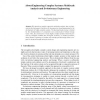VW
1998
Springer
14 years 6 months ago
1998
Springer
We suggest in this article a new paradigm for the representation of data, which is best suited for the real-time visualization and sonorisation of complex systems, real or simulat...
DATE
2010
IEEE
14 years 6 months ago
2010
IEEE
-- Starting Electronic System Level (ESL) design flows with executable High-Level Models (HLMs) has the potential to sustainably improve productivity. However, writing good HLMs fo...
CSCWD
2001
Springer
14 years 6 months ago
2001
Springer
Collaborative design is challenging because strong interdependencies between design issues make it difficult to converge on a single design that satisfies these dependencies and i...
HICSS
2003
IEEE
14 years 7 months ago
2003
IEEE
1 In the complexity and simulation communities there is growing support for the use of bottom-up computer-based simulation in the analysis of complex systems. The presumption is th...
HICSS
2003
IEEE
14 years 7 months ago
2003
IEEE
This paper1 provides a view of modeling the information dominance problem of military systems as representative of modeling other complex systems. The ideas are an extension of ea...
CCGRID
2003
IEEE
14 years 7 months ago
2003
IEEE
— Due to enormous complexity of the unstructured peer-to-peer networks as large-scale, self-configure, and dynamic systems, the models used to characterize these systems are eit...
ATAL
2004
Springer
14 years 7 months ago
2004
Springer
Abstract. We describe an analytic approach, multiscale analysis, that can demonstrate the fundamental limitations of decomposition based engineering for the development of highly c...
PCI
2005
Springer
14 years 7 months ago
2005
Springer
We address several recent developments in non-cooperative as well as evolutionary game theory, that give a new viewpoint to Complex Systems understanding. In particular, we discuss...
IDEAL
2005
Springer
14 years 7 months ago
2005
Springer
The design, development, and use of complex systems models raises a unique class of challenges and potential pitfalls, many of which are commonly recurring problems. Over time, res...
ICCBR
2005
Springer
14 years 7 months ago
2005
Springer
This paper describes how CBR can be used to compare, reuse, and adapt inductive models that represent complex systems. Complex systems are not well understood and therefore require...




